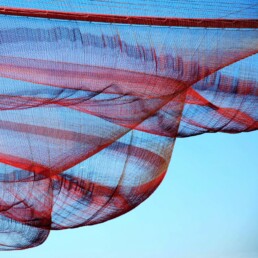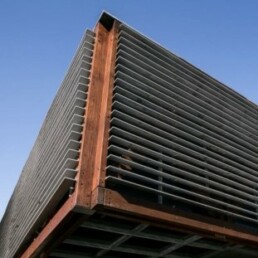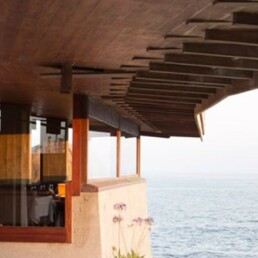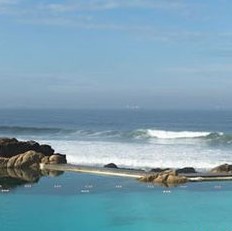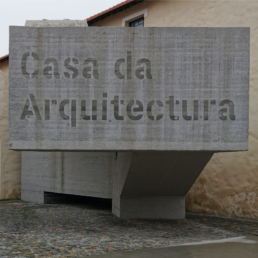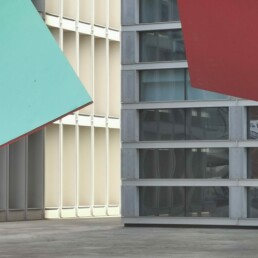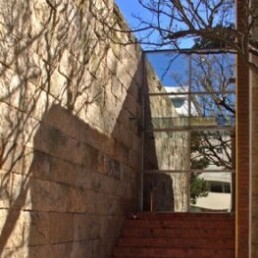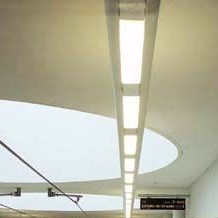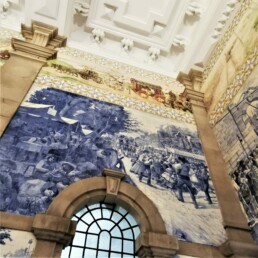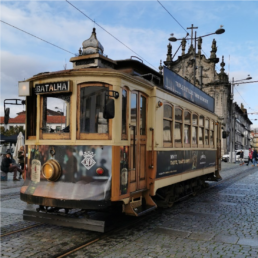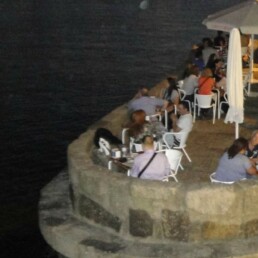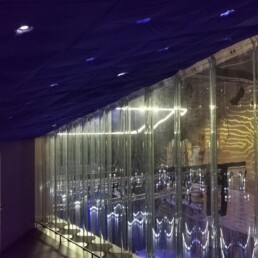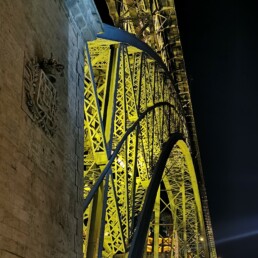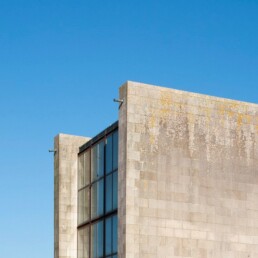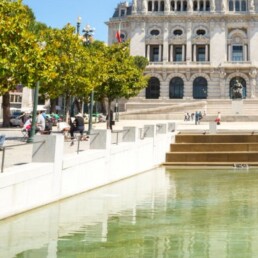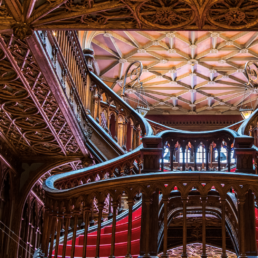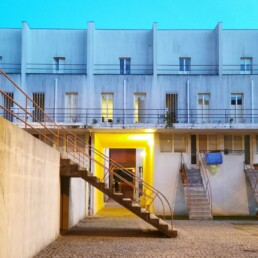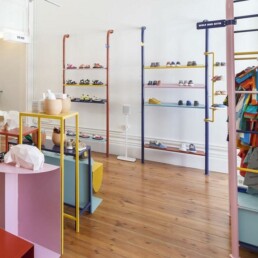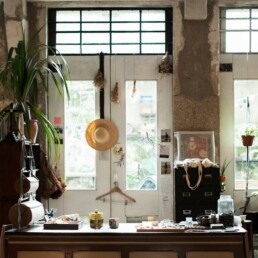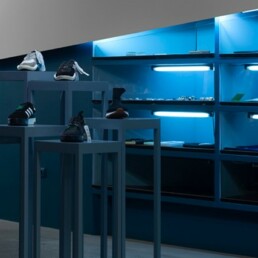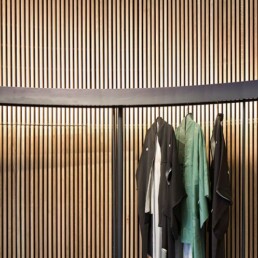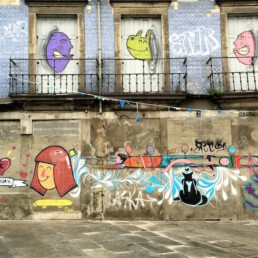Tagline
Reispas voor Porto
Porto is de tweede grootste stad van Portugal waar je ondergedompeld wordt in een ontspannen, zuiderse sfeer. Wandel door de nauwe, steile steegjes in de Ribeira wijk en snuif het unieke karakter op van de portostad. De kleurrijke authentieke huizen met typische ‘azulejos’, de open pleinen en de prachtige Dom Luisbrug behoren niet voor niets tot het Unesco-werelderfgoed.
SHE CHANGES
Het kunstwerk She Changes is in 2005 ontworpen door Janet Echelman, en is ondertussen het grafisch symbool van de stad Porto. Het is een gigantisch 3-dimensionaal net dat tot 27 meter hoog van de grond hangt aan 3 stalen palen. Het werk bestaat uit verschillende lagen allemaal uit zacht en flexibel materiaal die vloeiend bewegen door de wind. Dit creëert bewegende tekeningen van schaduw op de grond, die de choreografie van de wind benadrukken. Het is voornamelijke bedoeld om de geschiedenis van de stad als industrieel en vissers centrum uit te lichten, maar de bewoners geven er graag hun eigen betekenis aan, van vissersnetten en masten van boten tot de geschiedenis van de Portugese kant industrie. De palen zijn rood met wit beschilderd en staan zo voor de vele vuurtorens en schoorstenen in de buurt. Het net bestaat uit 36 verschillende secties, die met verschillende dichtheden geweven zijn, en ieders met de hand aan elkaar gezet zijn om zo de gelaagdheid van het werk te bekomen.
The artwork She Changes was designed by Janet Echelman in 2005, and is now the graphic symbol of the city of Porto. It is a gigantic 3-dimensional net that hangs up to 27 meters high from the ground on 3 steel poles. The work consists of different layers, all made of soft and flexible material that moves fluently in the wind. This creates moving drawings of shadows on the ground, emphasizing the choreography of the wind. It is mainly meant to highlight the history of the city as an industrial and fishing centre, but the inhabitants like to give it their own meaning, from fishing nets and masts of boats to the history of the Portuguese lace industry. The poles are painted red and white and stand in front of the many lighthouses and chimneys in the area. The net consists of 36 different sections, woven at different densities, each of which has been put together by hand in order to achieve the layering of the work.
CITY HALL
Het stadhuis van Porto is in 1955 gebouwd door de architect Antonio Correia Da Silva in samewerking met architect Carlos Ramos. Het heeft een klokkentoren van 70m hoog en binnenin 2 patios. Het 6 verdieping hoge gebouw heeft een gevel gemaakt van graniet en marmer, met stambeelden, die verwijzen naar dagelijkse activiteiten van Porto, in verwerkt gemaakt door de kunstenaars José Sousa, Caldas en Henrique Moreira. Binnenin bevat het gebouw prachtige plafondschilderingen van het wapenschild en de patroonheilige van Porto, uit de romantische periode.
Porto Town Hall was built in 1955 by the architect Antonio Correia Da Silva in collaboration with the architect Carlos Ramos. It has a bell tower of 70m high and inside 2 patios. The 6-storey building has a facade made of granite and marble, with tribal statues referring to daily activities of Porto, in incorporation by the artists José Sousa, Caldas and Henrique Moreira. Inside, the building contains beautiful ceiling paintings of the coat of arms and patron saint of Porto, from the romantic period.
THE WATER PAVILION
In het water paviljoen kan je op een interactieve manier het belang van de omgang met water inzien. Het paviljoen dat oorspronkelijk werd gebouwd voor de expo ’98, is in 2019 volledig gerenoveerd door dezelfde architect die het bouwde, Alexandre Burmester. Het grote doel van dit project is om de aandacht te bevestigen op watervervuiling, -schaarste en de rol van water in de klimaatverandering. Dit wordt gedaan door onder andere nieuwe technologieën, demonstraties en simulaties van situaties die we ons anders niet goed kunnen inbeelden te tonen en te doen begrijpen. Bovendien is er ook een labo waar je zelf kan experimenteren onder begeleiding van een expert. Het water paviljoen is elke dag, behalve zondag, open en toegankelijk voor bezoekers van 10u tot 17u30. Je betaalt als student 6€ voor een bezoek.
In the water pavilion you can see in an interactive way the importance of dealing with water. The pavilion that’s Originally built for the expo '98 , was completely renovated in 2019 by the same architect who built it, Alexandre Burmester. The main aim of this project is to confirm the focus on water pollution, scarcity and the role of water in climate change. This will be done by, among other things, showing and understanding new technologies, demonstrations and simulations of situations that we would otherwise not be able to imagine. In addition, there is also a lab where you can experiment under the supervision of an expert. The water pavilion is open every day, except Sundays, and open to visitors from 10h to 17h30. As a student, you pay 6€ for a visit.
CASA DE CHÁ DA BOA NOVA
Het theehuis Casa De Chá is gebouwd op rotsen hangend over de wilde zee door architect Àlvaro Siza. Het gebouw dat ondertussen geclassificeerd is als nationaal monument was volledig af in 1963. Siza kreeg de opdracht door architect Fernando Tavora, die de prijs won om het theehuis te bouwen van een wedstrijd georganiseerd door Camara de Matoshinhos in ’58. Er is een sterke relatie tussen interieur en exterieur gecreëerd aan de hand van glazen panelen die het onderscheid tussen gebouw en natuur moeilijk zichtbaar maakt. Het theehuis is te bereiken via een lang pad dat vertrekt van op de parking. Het pad is onthult doormiddel van dramatische perspectieven de rotslandschappen en de zee die schuilen onder het gebouw. Het gebouw heeft een aantal jaren onverzorgd leeg gestaan en is daarna gerenoveerd. In 2014 is het heropend als restaurant Boa Nova dat ondertussen met een Michelin ster menu mag ponken. Je kan in groepen van minstens 10 personen een architectuurtour boeken via Casa Da Arquitectura. (Minstens 3 dagen op voorhand reserveren!) Voor de extra ervaring kan je er natuurlijk ook eens chique gaan eten.
The teahouse Casa De Chá is built on rocks suspended over the wild sea by architect Àlvaro Siza. The building, now classified as a national monument, was completed in 1963. Siza was commissioned by architect Fernando Tavora, who won the prize to build the teahouse from a competition organised by Camara de Matoshinhos in ’58. A strong relationship between interior and exterior has been created by means of glass panels that make it difficult to distinguish between building and nature. The teahouse can be reached via a long path that starts from the car park. The path reveals through dramatic perspectives the rocky landscapes and the sea that lurk beneath the building. The building has been unkemptly empty for a number of years and was then renovated. In 2014 it will be reopened as restaurant Boa Nova that is now allowed to show off a Michelin star menu. You can book an architecture tour in groups of at least 10 people via Casa Da Arquitectura. (Book at least 3 days in advance!) For the extra experience you can of course also go there for a chic meal.
PISCINA DAS MARES
Eén van de eerste zelfstandige werken van architect Alvaro Siza is het zout water zwembad in Matoshinhos. Het is gebouwd tussen 1961 en 1966. De vertaling van Piscina Das Mares is “zwembad der zeeën” en het heeft zijn naam te danken aan de unieke locatie op een vaste rots grenzend aan de Atlantische oceaan waar de baden in direct contact zijn met de zee. De bedoeling van deze baden is om zwemmers het gevoel te geven dat ze in de wilde oceaan zwemmen maar dan zonder de gevaren van grote golven en harde stromingen. Doordat er geen bodemstudies van de locatie bestonden heeft Siza zelf veldonderzoek gedaan om de voormalige site zoveel mogelijk te kunnen integreren in het project en het als essentieel onderdeel te behouden. Dus zonder al te veel te veranderen aan de omgeving en aan de hand van minimale ingrepen bruikbare zwembaden te creëren. De betonnen wanden lopen verder in de zee en mengen zich met natuurlijke rotsen. De baden zijn zodanig ontworpen dat de zwemmers het verschil tussen het natuurlijke en kunstmatige nauwelijks uit elkaar kunnen halen. Materialen zoals beton, geoxideerd koper en donker hout zijn daarom ook in hun meest ruwe vorm gebruikt. Het volledige complex bevat een kinderbad en een bad voor volwassenen, ook is er een cafetaria en omkleedruimte. Bezoeken kan via een architectuurtour aangeboden door Casa Da Arquitectura. (Minstens 3 dagen op voorhand boeken!)
One of the first independent works by architect Alvaro Siza is the salt water swimming pool in Matoshinhos. It was built between 1961 and 1966. The translation of Piscina Das Mares is “pool of the seas” and it owes its name to its unique location on a solid rock bordering the Atlantic Ocean where the pools are in direct contact with the sea. The purpose of these baths is to give swimmers the feeling that they are swimming in the wild ocean but without the dangers of big waves and heavy flows. In the absence of soil studies of the site, Siza carried out its own field research in order to integrate the former site as much as possible into the project and preserve it as an essential part. So without making many changes to the environment and creating usable swimming pools with minimal interventions. The concrete walls continue into the sea and blend with natural rocks. The pools are designed in such a way that the swimmers can barely tell the difference between the natural and the artificial. Materials such as concrete, oxidised copper and dark wood have therefore also been used in their roughest form. The entire complex includes a children’s pool and an adult pool, as well as a cafeteria and changing room. Visits can be made via an architecture tour offered by Casa Da Arquitectura. (Book at least 3 days in advance!)
CASA DA ARQUITECTURA
Het Portugees center voor Architectuur heeft als missie om een divers publiek bekend te maken met nationale en internationale architectuur. Er wordt gedoken in de archieven van verschillende architecten dus je vindt er allerlei beeldmateriaal, maquettes, tekeningen etc. van bekende namen zoals Alvaro Siza en Souto De Moura, maar eveneens van minder bekende namen. De bedoeling van Casa Da Arquitectura is niet alleen om exposities te organiseren, maar ook om te fungeren als een culturele instelling die kwalitatief interessante informatie ter beschikking stelt en deelt binnen samenwerkingsverbanden op nationaal en internationaal niveau dit kunnen georganiseerde workshops, debatten zijn of hun eigen documentairecollectie. De vaste bezoeken die georganiseerd zijn vanuit Casa Da Arquitectura zijn bedoeld om architecturale pareltjes van gerenommeerde architect Siza en zijn connecties met Fernando Távora en Soute De Moura, in Matosinhos te promoten. Binnen dit vast aanbod vallen Casa de Chá da Boa Nova, Piscina das Marés, het zwembad Quinta da Conceição en het Roberto Ivens huis. Al deze gegidste tours worden geleid door gidsen met een opleiding in de architectuur en moeten minstens 3 dagen op voorhand geboekt worden. Check zeker ook met hoeveel personen je minstens moet zijn om een tour te kunnen volgen.
The mission of the Portuguese Centre for Architecture is to introduce national and international architecture to a diverse audience. Diving into the archives of various architects, you will find all kinds of images, models, drawings etc. of famous names such as Alvaro Siza and Souto De Moura, but also of lesser known names. The intention of Casa Da Arquitectura is not only to organise exhibitions, but also to function as a cultural institution that makes interesting information available and shares it within collaborations on a national and international level, which can be organised workshops, debates or their own documentary collection. The permanent visits organised from Casa Da Arquitectura are intended to promote architectural gems by renowned architect Siza and his connections with Fernando Távora and Soute De Moura, in Matosinhos.Within this fixed offer are Casa de Chá da Boa Nova, Piscina das Marés, the Quinta da Conceição swimming pool and the Roberto Ivens house. All these guided tours are led by guides with an education in architecture and must be booked at least 3 days in advance. Be sure to check how many people you need to be with in order to follow a tour.
TORRE BURGO
Wederom een project van architect Souto De Moura. Dit project werd door de jury van de Pirtzker prijs beschreven als “…twee gebouwen naast elkaar, één verticaal en één horizontaal met verschillende schalen, in dialoog met elkaar en het stadslandschap.” Met een knipoog naar de architectuur van Mies Van Der Rohe worden de hoogtes modulair uitgedrukt en wordt er nog steeds rekening gehouden met de richting van de zon. De 17 verdiepingen van het verticale gebouw zitten verstopt achter een gevelstructuur die het gebouw hoger doet lijken dat het werkelijk is. Het lage gebouw gaat meer op in zijn omgeving terwijl het hoge gebouw roept naar meer hoge gebouwen in de omgeving nu nog laag bebouwde omgeving. Wat ook noemenswaardig is, is het kunstwerk van Ângelo de Sousa dat voor de gebouwen staat. Het project dateert van 2007.
Another project by architect Souto De Moura. This project was described by the jury of the Pirtzker Prize as “…two buildings next to each other, one vertical and one horizontal with different scales, in dialogue with each other and the urban landscape”. With a nod to the architecture of Mies Van Der Rohe, the heights are expressed in a modular way and the direction of the sun is still taken into account. The 17 floors of the vertical building are hidden behind a facade structure that makes the building appear higher than it really is. The low building blends in more with its surroundings while the tall building calls out to more tall buildings in the area that are still low.
The project was completed in 2007. What is also worth mentioning is the work of art by Ângelo de Sousa that stands in front of the buildings.
CASA DES ARTES
In 1991 voltooide de grote architect Souto De Moura zijn eerste project, de Casa des Artes. Deze culturele plek is gebouwd tegenover Casa Allen gebouwd door architect José Marques da Silva in 1927. Het complex bestaat uit twee zalen voor concerten en conferenties met tussenin een grote tentoonstellingsruimte. Ondergronds bevindt zich ook nog een serviceruimte. Wat centraal staat bij de architectuur van het gebouw is, de eenvoud en integratie met het domein errond. Sinds 2012 is het volledige domein met de grote tuinen en Casa Allen inbegrepen geclassificeerd als monument van openbaar belang. Architectuur rondleidingen in groep kunnen gevolgd worden via Cultour. Voor groepen van 10 tot 25 personen betaal je €5 en voor groepen van 26 tot 40 personen slecht €4.
In 1991, the great architect Souto De Moura completed his first project, the Casa des Artes. This cultural site was built opposite Casa Allen by the architect José Marques da Silva in 1927. The complex consists of two halls for concerts and conferences with a large exhibition space in between. Underground there is also a service area. What is central to the architecture of the building is its simplicity and integration with the estate around it. Since 2012, the entire domain with its large gardens and Casa Allen included has been classified as a monument of public interest. Architectural tours in groups can be followed via Cultour. For groups of 10 to 25 people you pay €5 and for groups of 26 to 40 people only €4.
METRO SALGUEIROS
Het metronetwerk van Porto is ontworpen door Architect Eduardo Souto De Moura en hij heeft maar liefst 12 van de stations gebouwd. Waaronder ook het station Salgueiros dat gebouwd is op de plaats van een verlaten voetbalveld. Souto streeft er naar dat de stedelijke ruimte zich voortzet ondergronds. Hier doet hij dat onder andere door natuurlijk licht en continuïteit van de beweging van voetgangers te creëren aan de hand van grote koepels. Deze zouden staan voor de grote ogen die kijken op de ingewanden van de aarde. Bovendien probeerde hij steeds de stations over te laten gaan in hun omgeving.
The Porto metro network was designed by Architect Eduardo Souto De Moura and he built no less than 12 of the stations. Including the Salgueiros station, which was built on the site of an abandoned football field. Souto strives for the urban space to continue underground. Here he does this by creating natural light and continuity of movement of pedestrians by means of large domes. These would represent the big eyes looking at the bowels of the earth. Moreover, he always tried to make the stations blend into their surroundings.
SAO BENTO METRO
Het metro station São Bento is in 2005 ontworpen door Alvaro Siza Vieira. De pasteltinten, witte betonnen muren en symmetrie vormen een harmonieus geheel dat kan worden teruggevonden op zowel architecturale schaal als op de schaal van het productontwerp. Als je goed kijkt vind je over het hele station tegeltjes die bedrukt zijn met schetsjes van de architect zelf. Ook heeft hij er een reeks elementen in verwerkt die verwijzen naar zijn eerdere werken.
The metro station São Bento was designed in 2005 by Alvaro Siza Vieira. The pastel shades, white concrete walls and symmetry form a harmonious whole that can be found on both architectural and product design scales. If you look closely, you will find tiles printed with sketches by the architect himself all over the station. He has also incorporated a series of elements that refer to his earlier works.
GUINDAIS ELEVATOR
Om op een unieke en snelle manier van de kade in Ribeira naar het plateau van Batalha ta gaan, kan je de 281m lange kabelspoorweg gebruiken. Een enkel ritje heeft een reistijd van slechts 3 minuten en kan je al den voor €2,50. Het is niet alleen efficiënt, want na een 90m lange tunnel wacht een mooi panoramisch uitzicht. Het is bovendien ook één van de sterkst hellende kabelspoorwegen ter wereld met een hoogteverschil van 61m. Je zal in één van de twee rijtuigen belanden waar max. 25 personen in kunnen.
Van oktober tot en met mei is de baan open van zondag t/m donderdag van 8u tot 20u en vrijdag tot zaterdag van 8u tot 00u. Voor juni tot en met september is dit van zondag t/m woensdag van 8u tot 22u en donderdag t/m zaterdag van 8u tot 00u.
To get from the quay in Ribeira to the Batalha ta plateau in a unique and fast way, you can use the 281m long funicular. A single ride has a journey time of only 3 minutes and can be done for €2.50. It is not only efficient, because after a 90m long tunnel a nice panoramic view awaits you. It is also one of the most sloping funiculars in the world with a height difference of 61m. You will end up in one of the two carriages that can accommodate up to 25 people.
From October to May, the track is open from Sunday to Thursday from 8 a.m. to 8 p.m. and Friday to Saturday from 8 a.m. to midnight. For June to September it is from Sunday to Wednesday from 8h to 22h and Thursday to Saturday from 8h to 00h.
PRACA DE BATALHA
Het Batalha plein in het hartje van het centrum van Porto is een symbool voor de stad. Er bevinden zich rondom veel historische gebouwen zoals een Cinema in een Art-Deco gebouw daterend uit 1947 en het Koninklijk Theater. Het is al eeuwenlang een belangrijke culturele spot die nu ook voor toeristen een pleister is door de cafés en hotels die zich daar talrijk bevinden.
The Batalha square in the heart of the centre of Porto is a symbol of the city. It is surrounded by many historic buildings such as a Cinema in an Art-Deco building dating from 1947 and the Royal Theatre. It has been an important cultural spot for centuries and is now a haven for tourists due to the many cafes and hotels that are located there.
BAR PONTE PENSIL
Gezellig tapas eten en een Porto tonico (de variant van een Gin tonic) drinken kan in deze bar vlak aan de brug Ponte Dom Luis. Voor veel leven in de brouwerij op een terras vlak aan het water moet je hier zijn! Let wel op dat de meeuwen niet met je lekker bord tapas gaan vliegen.
Eating tapas and drinking a Porto tonico (the variant of a Gin tonic) can be enjoyed in this bar right by the bridge Ponte Dom Luis. For a lively atmosphere on a terrace near the water you have to be here! Please note that the seagulls won’t fly with your nice plate of tapas
CASA DA MUSICA
Het grote concertgebouw Casa De Musica is ontworpen door Nederlandse architect Rem Koolhaas. Volgens de oorspronkelijke planning zou in het jaar 2001, wanneer Porto culturele hoofdstad van Europa was, het gebouw af moeten geweest zijn. In werkelijkheid vond het openingsconcert pas plaats in 2005. De grote concertzaal, die plaats kan bieden voor 1238 personen ligt centraal in het gebouw en bevat 5 grote glaspartijen die transparantie en lichtinval bieden. Aan deze ramen grenzen nog 5 kleinere ruimtes met elks een ander doel. Zo is er nog een kleinere concertzaal met een VIP ruimte, een stille kamer met dempende elementen tegen de muur, relax unit, actieve kamer en een perspectiefkamer. Je kan doorheen het gebouw een gegidste tour in het Engels volgen van maandag tot vrijdag. Om de volledige ervaring te hebben, kan je een concert bijwonen. Op de website vind je kortingen voor verschillende situaties.
The large concert hall Casa De Musica was designed by Dutch architect Rem Koolhaas. According to the original planning, the building should have been finished in the year 2001, when Porto was European Capital of Culture. In reality, the opening concert only took place in 2005. The large concert hall, which can seat 1238 people, is centrally located in the building and contains 5 large glass sections that provide transparency and light. These windows are bordered by 5 smaller rooms, each with a different purpose. There is a smaller concert hall with a VIP area, a quiet room with dampening elements against the wall, relax unit, active room and a perspective room. You can follow a guided tour through the building in English from Monday to Friday. To have the full experience, you can attend a concert. On the website you will find discounts for different situations.
PONTE DOM LUIS
De bekendste brug van de stad over de Douro is toch wel de Ponte dom Luis. Hij bestaat uit 2 wegdekken die 44m boven elkaar liggen. Eén voor de tram en Eén voor auto’s, voetgangers kunnen op beide delen een wandeling maken, maar vanaf het bovenste wegdek is het uitzicht over de stat en de Douro toch net dat tikkeltje indrukwekkender. De twee delen zijn verbonden door een boogconstructie tussen de wegdekken. Van 1881 tot 1886 werkte de ontwerper Teófilo Seyrig (een medewerker van Gustave Eiffel) aan de stalen brug.
The most famous bridge of the city over the Douro is the Ponte dom Luis. It consists of 2 road decks 44m above each other. One for the tram and one for cars, pedestrians can take a walk on both parts, but from the upper road surface the view over the city and the Douro is just about that extra bit more impressive. The two parts are connected by a steel arch construction between the road surfaces. From 1881 to 1886 the designer Teófilo Seyrig (an employee of Gustave Eiffel) worked on the steel bridge.
SÉ CATHEDRAL
De Sé kathedraal is één van de meest populaire toeristische attracties van de stad en ondertussen een nationaal monument. De bouwwerken ervan zijn begonnen in de twaalfde eeuw maar het is over de eeuwen heen een mix geworden van verschillende bouwstijlen. Aan de kathedraal bevind zich een klooster dat samen met één van de kapellen voornamelijk een gotische bouwstijl heeft, het grootste deel van de kathedraal is barok maar de gevel en het schip dan weer Romaans. Je kan de kathedraal zelf gratis bezoeken en voor €3 kan je ook in het klooster een kijkje gaan nemen.
The Sé Cathedral is one of the city’s most popular tourist attractions and is now a national monument. Its construction began in the twelfth century but over the centuries it has become a mix of different architectural styles. At the cathedral there is a monastery which, together with one of the chapels, mainly has a Gothic architectural style, most of the cathedral is baroque but the facade and the nave are Romanesque. You can visit the cathedral for free and for €3 you can also have a look in the monastery.
CASA DA CAMARA (CASA DOS 24)
De Casa Da Camara, dat zich naast de Se kathedraal bevindt en grenst aan de muren rond de heuvel van de kathedraal, is oorspronkelijk gebouwd in de 15e eeuw. Toen functioneerde het als stadhuis en de eerste zetel van de gemeente. De 24 vertegenwoordigers van Porto kwamen hier samen. Vandaar ook wel de naam Casa Dos 24. In 1875 tijdens de zware branden die in Porto plaatsvonden werd het gebouw hard beschadigd. Architect Fernando Távora bouwde het opnieuw op in de jaren 2000 met respect voor de originele afmetingen. Vandaag de dag functioneert het als toeristisch kantoor.
The Casa Da Camara, located next to the Se cathedral and adjacent to the walls around the cathedral hill, was originally built in the 15th century. At that time it functioned as the town hall and the first seat of the municipality. The 24 representatives of Porto met here. Hence the name Casa Dos 24. In 1875 during the heavy fires that took place in Porto, the building was badly damaged. Architect Fernando Távora rebuilt it in the 2000s with respect for its original dimensions. Today it functions as a tourist office.
ALIADOS
De boulevard van Aliados wordt ook wel eens het kloppende hart van het centrum van Porto genoemd. De avenue is omringd door prachtige historische gebouwen zoals verschillende banken, het stadhuis en Hotel Aliados. De Aliados in in zijn huidige indrukwekkende staat als “statement” locatie sinds 1916. Het stadhuis (Câmara Municipal) dat zich aan het uiteinde van de boulevard bevindt, heeft een indrukwekkende klokkentoren van zo’n 70 meter hoog. Een leuk extraatje is dat zich hier zogezegd “de mooiste” McDonalds ter wereld bevindt.
The promenade of Aliados is also known as the beating heart of the centre of Porto. The avenue is surrounded by beautiful historic buildings such as several banks, the town hall and Hotel Aliados. The Aliados in its present impressive state as a statement location since 1916. The town hall (Câmara Municipal) at the end of the promenade has an impressive bell tower of about 70 meters high. A nice extra is that here you will find “the most beautiful” McDonalds in the world.
LIVRARIA LELLO
Deze adembenemende boekenwinkel die bekend staat als één van de meest symbolische ter wereld werd gebouwd in 1906 door de ingenieur Xavier Esteves. Het gebouw in eclectische bouwstijl bevat langs buiten kleurrijke neogotisch geïnspireerde schilderingen. Het interieur is in Art Nouveau stijl met Art Deco elementen in de details. De binnenkant van de winkel bevat iconische elementen zoals het prachtig plafond en de Crimson trap in het midden van de ruimte. Om binnen te geraken moet je een paar huizen verder een voucher aankopen, waarvan je in de winkel zelf voor de waarde van je voucher aankopen kan doen.
This breathtaking bookshop known as one of the most symbolic in the world was built in 1906 by the engineer Xavier Esteves. The eclectic building contains colourful neo-Gothic-inspired paintings on the outside. The interior is in Art Nouveau style with Art Deco elements in the details. The inside of the shop contains iconic elements such as the beautiful ceiling and the Crimson staircase in the middle of the space. To get inside you have to buy a voucher a few houses further, which you can buy in the shop itself for the value of your voucher.
CONJUNTO HABITACIONAL DA BOUCA
In de jaren ’70 waren de woonomstandigheden in de stad erg zorgwekkend door de Portugese revolutie. Om deze te verlichten werden sociale woningen gebouwd in de wijk Bouça. Het bureau SAAL waarvoor de architect Álvaro Siza werkte tussen 1973 en 1977 kreeg de kans om hier een hele wijk te bouwen. De volledige plannen van Siza, waarbij nog twee extra blokken en gemeenschappelijke ruimtes zoals wasplaats en bibliotheek zouden komen, zijn uiteindelijk niet uitgevoerd. De blokken die er wel zijn gekomen grenzen aan de spoorweg wat de buurt origineel niet zo populair maakte. Als oplossing tegen het lawaai zijn de achterwanden van de woningen dubbel zo dik. De blokken bestaan uit 4 verdiepingen met telkens 2 woningen in. De onderste woning is groter dan de bovenste doordat er terrassen zitten bij de bovenste appartementen. Een grote troef is dat de woningen afzonderlijke ingangen hebben.
In the 1970s, living conditions in the city were very worrying due to the Portuguese Revolution. In order to alleviate them, social housing was built in the Bouça district. The SAAL agency, for which the architect Álvaro Siza worked between 1973 and 1977, was given the opportunity to build a whole neighbourhood here. Siza’s complete plans, which included two additional blocks and common areas such as a laundry room and library, were not realised in the end. The blocks that were built were bordering on the railway, which did not make the neighbourhood very popular in its original form. As a solution against the noise, the back walls of the houses are twice as thick. The blocks consist of 4 floors with 2 houses each. The lower house is larger than the upper one because there are terraces near the upper flats. A major advantage is that the dwellings have separate entrances.
CENTRO PORTUGUÊS DE FOTOGRAFIA
Porto is de belangrijkste stad voor fotografie in Portugal. Het museum dat hier aan gewijd is, is dan ook absoluut de moeite waard om te bezoeken. De oude 18e eeuwse gevangenis Cadeia da Relação, is in 1997 omgebouwd tot een museum voor fotografie. Toen was enkel nog maar het gelijkvloers in gebruik terwijl sinds de renovaties in 2001 door de architecten Eduardo Souto Moura en Humberto Vieira het volledige gebouw in gebruik is door het CPF (Centro Portuguës de Fotografia). Je kan er de verschillende vaste tentoonstellingen bezoeken met onder andere de nationale collectie van fotografie en oud fotografisch apparatuur. Voor de rest zijn er verschillende ruimtes vrijgehouden voor Portugese en Braziliaanse fotografie en voor studenten die hun werk willen tentoonstellen. Bovendien kan je nog restanten van de gevangenis waarnemen en bevat het gebouw één van de beste panorama spots van de stad.
Porto is the most important city for photography in Portugal. The museum dedicated to it is therefore definitely worth a visit. The old 18th century prison, Cadeia da Relação, was converted into a museum for photography in 1997. At that time only the ground floor was in use while since the renovations in 2001 by the architects Eduardo Souto Moura and Humberto Vieira, the entire building is in use by the CPF (Centro Portuguës de Fotografia). There you can visit the various permanent exhibitions, including the national collection of photography and old photographic equipment. In addition, there are several spaces available for Portuguese and Brazilian photography and for students who want to exhibit their work. In addition, you can observe the remains of the prison and the building contains one of the best panoramic spots in the city.
THE FEETING ROOM
Een samenwerking tussen verschillende merken dat ondertussen een keten van 3 conceptstores in Portugal (waarvan 2 in Porto) is geworden. Wat begon als voornamelijk een schoenenwinkel is nu uitgebouwd tot een concept waarbij lokale en zelfstandige merken van kleding, schoenen en huisspullen gepromoot worden. Tijdens een dagje uit kan je in beiden filialen ook even tot rust komen in hun binnenplaats dat is omgetoverd tot gezellig café voor zowel brunch en koffie als apéro met cocktails.
A collaboration between different brands that has now become a chain of 3 concept stores in Portugal (of which 2 in Porto). What started as mainly a shoe shop has now developed into a concept promoting local and independent brands. During a day out you can also relax in both branches in their courtyard which has been transformed into a cosy café for brunch and coffee as well as apéro with cocktails.
EARLY MADE
In een industrieel pand in het hartje van het Art district van Porto bevind zich de concept store Early Made. Een combo van een mode en lifestyle winkel en een artistiek platform. Wat zowel de kunst, vintage-design, boeken, kleding etc. die ze tentoonstellen en verkopen gemeen hebben is het hedendaagse “made in Portugal” gegeven.
The Early Made concept store is located in an industrial building in the heart of Porto’s Art district. A combo of a fashion and lifestyle shop and an artistic platform. What art, vintage design, books, clothing etc. they exhibit and sell have in common is the contemporary “made in Portugal” concept.
CORACÃO ALECRIM
Een winkel boordevol spulletjes en kleding waarbij de focus ligt op duurzaamheid en liefde voor de natuur. Alles wat je hier vind is fair-trade, handgemaakt en van lokale bodem. Bovendien zijn alle producten een streling voor het oog door hun eenvoud.
A shop full of items where the focus is on sustainability and love of nature. Everything you find here is fair-trade, handmade and from local soil. What’s more, all the products are a delight to the eye because of their simplicity.
WRONG WEATHER STORE
Een trendy winkel in het commercieel hart van Porto met onder andere een veelzijdige installatie van Italiaanse architect Francesco Moncada. Bovenop het vinden van de hipste mode van dat moment, wordt er ook het werk van opkomende artiesten en creatievelingen getoond. Met andere woorden een walhalla dus voor zij die genieten van een mix van architectuur en fotografie tot mode en design. Sinds kort is er naast de flagship store ook Wrong Weather Life. Hier wordt de focus gelegd op street- en sportswear.
A trendy store in the commercial heart of Porto with, among other things, a versatile installation by Italian architect Francesco Moncada. In addition to finding the hippest fashion of the moment, the work of up-and-coming artists and creatives is also on display. In other words, a walhalla for those who enjoy a mix of architecture and photography to fashion and design. Recently, besides the flagship store, there is also Wrong Weather Life. Here the focus is on street and sportswear.
MÃO ESQUERDA VINTAGE STORE
Deze kleine maar oogverblindende vintage winkel is gebouwd door de architect Gustavo Guimarães in 2017. Het situeert zich in de “Fine-arts” buurt en je vindt er high-fashion kleding van over de hele wereld. Het is één van de bekendste Portugese vintage kledingmerken. Het 19m² pand is ingericht met 2 gebogen hoofdelementen aan de hand van ijzer en eik en aangevuld met een refurbished toonbank. Het is visueel een sterke mix tussen het ruwe aspect van het historisch pand en minimaal hedendaags design.
This small but dazzling vintage store was built by the architect Gustavo Guimarães in 2017. It is located in the Fine-arts neighborhood and you will find high-fashion clothing from all over the world. It is one of the most famous Portuguese vintage clothing brands. The space of only 19m² is decorated with 2 main curved elements made of iron and oak and complemented by a refurbished counter. It is visually a strong mix between the raw aspect of the historic building and minimal contemporary design.
CIRCUS NETWORK
Winkel, coworking space, galerij, allemaal in 1 in het centrum van Porto’s Art district. Hier vind je een samenkomt van werken van Portugese creatievelingen me de focus op illustraties, design en stadskunst.
A shop, coworking space, gallery, all in 1 in the centre of Porto’s Art district. Here you will find a collection of works by Portuguese creatives with a focus on illustration, design and urban art.
MIGUEL BOMBARDA ARTBLOCK
Een volledige straat vol cultuur en kunst. In de Rua Miguel Bombarda vindt je eindeloze Street art werken van verschillende kunstenaars. Bovendien gaan er minstens 6 keer per jaar (met telkens anderhalve maand ertussen) meer dan 20 hedendaagse kunstgalerijen open in de straat en de rest van de buurt. Na alles wat met kunst en cultuur te maken heeft, zijn hippe bars en winkeltjes gevolgd waardoor het ontpopt is tot de hippe “arty” wijk van Porto. Met andere woorden een culturele kern voor kunst- en sfeerliefhebbers.
A complete street full of culture and art. In the Rua Miguel Bombarda you will find endless street art works by different artists. Moreover, at least 6 times a year (with a month and a half each time in between) more than 20 contemporary art galleries open in the street and the rest of the neighborhood. After everything that has to do with art and culture, hip bars and shops have followed, making it the hip "arty" district of Porto. In other words, a cultural core for art lovers who like vibrant areas.
CLAUS PORTO
Een 300m² groot herenhuis met 3 verdiepingen. Op het gelijkvloers bevindt zich de Claus winkel zelf met een gigantisch gamma aan zeepjes en parfums en andere badproducten. Al 133 jaar hebben ze hun portfolio aangevuld met kleurrijke en authentieke labels en patronen. Op de tweede verdieping is de historiek van het merk tentoongesteld en de derde verdieping wordt gebruikt als een ruimte voor workshops en nieuwe experimenten.
A 300m² store in an old townhouse with 3 floors. On the ground floor is the Claus store itself with a huge range of soaps, perfumes and other bath products. For 133 years they have complemented their portfolio with colorful and authentic labels and patterns. On the second floor the history of the brand is exhibited and the third floor is used as a space for workshops and new experiments.
